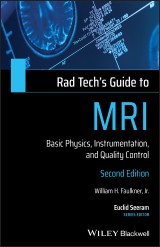Details
Rad Tech's Guide to MRI
Basic Physics, Instrumentation, and Quality ControlRad Tech's Guides' 2. Aufl.
|
36,99 € |
|
| Verlag: | Wiley-Blackwell |
| Format: | EPUB |
| Veröffentl.: | 06.01.2020 |
| ISBN/EAN: | 9781119509509 |
| Sprache: | englisch |
| Anzahl Seiten: | 144 |
DRM-geschütztes eBook, Sie benötigen z.B. Adobe Digital Editions und eine Adobe ID zum Lesen.
Beschreibungen
<p>The second edition of <i>Rad Tech's Guide to MRI</i> provides practicing and training technologists with a succinct overview of magnetic resonance imaging (MRI). Designed for quick reference and examination preparation, this pocket-size guide covers the fundamental principles of electromagnetism, MRI equipment, data acquisition and processing, image quality and artifacts, MR Angiography, Diffusion/Perfusion, and more.</p> <p>Written by an expert practitioner and educator, this handy reference guide:</p> <ul> <li>Provides essential MRI knowledge in a single portable, easy-to-read guide</li> <li>Covers instrumentation and MRI hardware components, including gradient and radio-frequency subsystems</li> <li>Provides techniques to handle flow imaging issues and improve the quality of MRIs</li> <li>Explains the essential physics underpinning MRI technology</li> </ul> <p><i>Rad Tech's Guide to MRI</i> is a must-have resource for student radiographers, especially those preparing for the American Registry of Radiation Technologist (ARRT) exams, as well as practicing radiology technologists looking for a quick reference guide.</p>
<p><b>1. </b><b>Hardware Overview 1</b></p> <p>Instrumentation: Magnets 1</p> <p>Instrumentation: RF Subsystem 6</p> <p>Instrumentation: Gradient Subsystem 8</p> <p><b>2. </b><b>Fundamental Principles 11</b></p> <p>Electromagnetism: Faraday’s Law of Induction 11</p> <p>Magnetism 12</p> <p>Behavior of Hydrogen in a Magnetic Field 14</p> <p><b>3. </b><b>Production of Magnetic Resonance Signal 19</b></p> <p><b>4. </b><b>Relaxation and Tissue Characteristics 23</b></p> <p>T2-Relaxation 23</p> <p>T1-Relaxation 24</p> <p>Proton Density 24</p> <p>T2* (Pronounced “T2 star”) 25</p> <p><b>5. </b><b>Data Acquisition and Image Formation 27</b></p> <p>Pulse Sequences 27</p> <p>Image Contrast Control 30</p> <p>Image Formation 42</p> <p>Data Acquisition 43</p> <p>Scan Time 50</p> <p>Controlling Image Quality with FSE 57</p> <p><b>6. </b><b>Magnetic Resonance Image Quality 61</b></p> <p>Spatial Resolution 61</p> <p>Signal-to-Noise Ratio (SNR) 63</p> <p><b>7. </b><b>Artifacts 75</b></p> <p>Chemical Shift (Water and Fat in Different Voxels) 75</p> <p>Chemical Shift (Water and Fat in the Same Voxel) 77</p> <p>Magnetic Susceptibility 79</p> <p>Motion and Flow 81</p> <p>Spatial Presaturation 82</p> <p>Gradient Moment Nulling (Flow Compensation) 84</p> <p>Compensation for Respiration 84</p> <p>Cardiac Compensation 86</p> <p>Aperiodic Motion 88</p> <p>Aliasing 89</p> <p>Gibbs and Truncation Artifact 91</p> <p>Radio-Frequency Artifacts 92</p> <p>Gradient Malfunctions 93</p> <p>Image Shading 93</p> <p>Inadequate System Tuning 94</p> <p>Reconstruction Artifacts 94</p> <p><b>8. </b><b>Flow Imaging 97</b></p> <p>Flow Patterns 97</p> <p>Magnetic Resonance Angiography (Non Contrast) 98</p> <p>Reduction of Flow Artifacts 102</p> <p>Signal Loss in MRA 102</p> <p>Two-Dimensional and Three-Dimensional Time-of-Flight 103</p> <p>Signal Loss with Two-Dimensional TOF 104</p> <p>Three-Dimensional TOF 106</p> <p>Signal Loss with Three-Dimensional TOF 108</p> <p>PC Techniques 109</p> <p>Contrast Enhanced MRA (CE-MRA) 113</p> <p><b>9. </b><b>Diffusion and Perfusion Imaging 117</b></p> <p>Diffusion-Weighted Imaging (DWI) 117</p> <p><b>10. </b><b>Gadolinium-Based Contrast Agents 125</b></p> <p>Characteristics, Composition and Structure 125</p> <p>Index 129</p>
<p><b>William H. Faulkner, Jr.</b> is a radiologic technologist and MRI education and operations consultant with William Faulkner and Associates. He is a founding board member of the American Board of Magnetic Resonance Safety (ABMRS) and author and co-author of several books on magnetic resonance imaging and computed tomography including the <i>Handbook of MRI Technique</i> and<i> Review Questions for MRI</i>.
<p>The second edition of <i>Rad Tech's Guide to MRI</i> provides practicing and training technologists with a succinct overview of magnetic resonance imaging (MRI). Designed for quick reference and examination preparation, this pocket-size guide covers the fundamental principles of electromagnetism, MRI equipment, data acquisition and processing, image quality and artifacts, MR Angiography, Diffusion/Perfusion, and more. <p>Written by an expert practitioner and educator, this handy reference guide: <ul> <li>Provides essential MRI knowledge in a single portable, easy-to-read guide</li> <li>Covers instrumentation and MRI hardware components, including gradient and radio-frequency subsystems</li> <li>Provides techniques to handle flow imaging issues and improve the quality of MRIs</li> <li>Explains the essential physics underpinning MRI technology</li> </ul> <p><i>Rad Tech's Guide to MRI</i> is a must-have resource for student radiographers, especially those preparing for the American Registry of Radiation Technologist (ARRT) exams, as well as practicing radiology technologists looking for a quick reference guide.


















